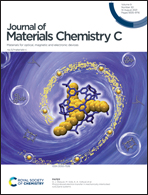Recent progress in tailoring the properties of inorganic CsPbX3 perovskites with functional organic compounds: a route to enhanced efficiency and operational stability in CsPbX3-based photovoltaics
Abstract
Due to their superior thermostability, inorganic CsPbX3 halide perovskites are considered the most promising photoabsorbers for commercially viable photovoltaic devices compared to their organic–inorganic analogs, which have demonstrated very impressive solar cell efficiency evolution in a few years though. However, the photoactive phases of most members, including CsPbI3 and iodide-rich CsPbI3−XBrX with suitable bandgaps for photovoltaic applications, of this CsPbX3 family are metastable at room temperature and/or humidity, which severely limits the development of their solar devices. Additionally, single-junction CsPbX3 perovskite solar cells (PSCs) have shown low efficiencies so far, which is mainly attributed to considerable crystal defect-related and non-optimal morphology-induced energy losses in the used CsPbX3 polycrystalline films. Accordingly, a broad range of organic species have been proposed to overcome these limitations and have been commonly used for the fabrication of CsPbI3 and CsPbI3−XBrX PSCs with efficiencies exceeding 15%. In this review, we first describe the mechanisms, such as tolerance factor tuning, suppression of lattice distortion and structural dimensionality tailoring, through which organic species are employed to thermodynamically stabilize the photovoltaic phases of CsPbI3 and CsPbI3−XBrX polymorphs under ambient conditions. Then, we show how molecular engineering could play a key role in the solution processing of high quality and low-temperature CsPbX3 perovskite films, and discuss the point defect passivation with organic ligands in CsPbX3 materials while highlighting the positive impact on the device efficiency and stability, as well as in the mitigation of the hysteresis phenomenon in the measurement of the current–voltage (I–V) performance of CsPbX3 PSCs. Lastly, we outline promising research pathways based on molecular engineering for the development of CsPbX3 materials with enhanced phase stability and photovoltaic properties.



 Please wait while we load your content...
Please wait while we load your content...